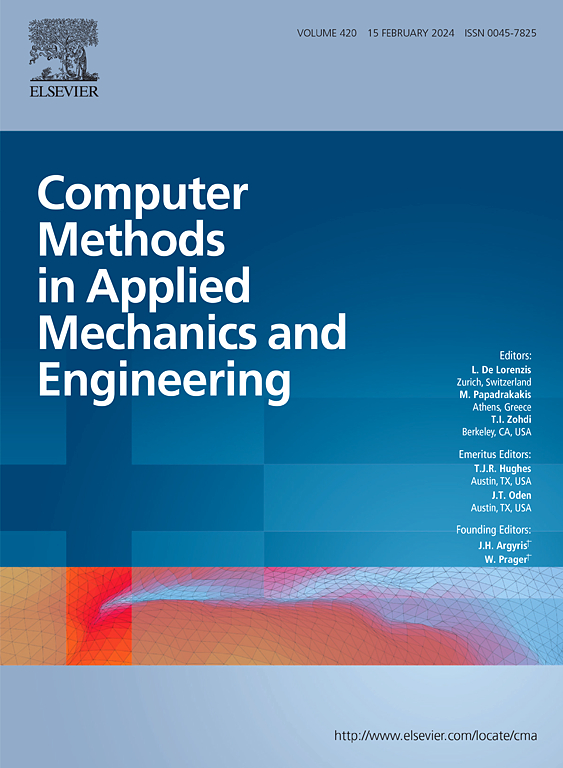Adaptive phase-field smoothed total Lagrangian material point method for fracture analysis of soft materials involving large deformation
IF 7.3
1区 工程技术
Q1 ENGINEERING, MULTIDISCIPLINARY
Computer Methods in Applied Mechanics and Engineering
Pub Date : 2025-07-29
DOI:10.1016/j.cma.2025.118250
引用次数: 0
Abstract
An adaptive phase-field smoothed total Lagrangian material point method (APS-TLMPM) is proposed in this paper to analyze the fracture behavior of nearly incompressible materials. The total Lagrangian material point method (TLMPM) combining with the phase-field model (PFM) is developed to describe the fracture behavior and solve the governing equations. Moreover, a hybrid F-bar method is developed to effectively alleviate volumetric locking caused by the nearly incompressible nature of soft materials. The physically meaningful and numerically induced volumetric changes are distinguished based on the pressure field to mitigate the inconsistency between the incompressibility constraint and the diffusive crack model. To efficiently solve the phase-field governing equations, an adaptive mesh refinement (AMR) algorithm is developed to refine the background grid and particles near the crack tip. Meanwhile, a unified formulation for constructing interpolation functions is established based on corrected smoothed kernel functions to efficiently handle transition grid with hanging nodes generated by the AMR. Finally, the accuracy and effectiveness of the proposed method for simulating the fracture of nearly incompressible materials are demonstrated through several representative numerical examples and comparisons with experimental results.
大变形软质材料断裂分析的自适应相场光滑全拉格朗日材料点法
本文提出了一种自适应相场光滑全拉格朗日材料点法(APS-TLMPM),用于分析近不可压缩材料的断裂行为。提出了结合相场模型的全拉格朗日物质点法(TLMPM)来描述断裂行为并求解控制方程。此外,开发了一种混合F-bar方法,以有效缓解软质材料几乎不可压缩特性引起的体积锁定。基于压力场区分了物理意义上的体积变化和数值上的体积变化,以缓解不可压缩性约束与扩散裂纹模型之间的不一致性。为了有效地求解相场控制方程,提出了一种自适应网格细化算法,对裂纹尖端附近的背景网格和粒子进行细化。同时,基于修正后的光滑核函数,建立了统一的插值函数构造公式,以有效处理AMR生成的挂节点过渡网格。最后,通过几个有代表性的数值算例和与实验结果的比较,验证了所提方法模拟近不可压缩材料断裂的准确性和有效性。
本文章由计算机程序翻译,如有差异,请以英文原文为准。
求助全文
约1分钟内获得全文
求助全文
来源期刊
CiteScore
12.70
自引率
15.30%
发文量
719
审稿时长
44 days
期刊介绍:
Computer Methods in Applied Mechanics and Engineering stands as a cornerstone in the realm of computational science and engineering. With a history spanning over five decades, the journal has been a key platform for disseminating papers on advanced mathematical modeling and numerical solutions. Interdisciplinary in nature, these contributions encompass mechanics, mathematics, computer science, and various scientific disciplines. The journal welcomes a broad range of computational methods addressing the simulation, analysis, and design of complex physical problems, making it a vital resource for researchers in the field.

 求助内容:
求助内容: 应助结果提醒方式:
应助结果提醒方式:


